| Revision as of 19:45, 22 April 2024 editCrunchydillpickle (talk | contribs)Extended confirmed users11,005 editsm →AnimalsTag: Visual edit← Previous edit | Revision as of 02:08, 25 April 2024 edit undo2601:1c0:5901:c1d0:c8b0:ec73:b6d0:d55d (talk)No edit summaryTag: RevertedNext edit → | ||
| Line 13: | Line 13: | ||
| The opposite of night is ] (or "]", to distinguish it from "day" referring to a 24-hour period time). ] is the period of night after sunset or before sunrise when the Sun still illuminates the sky when it is below the horizon. At any given time, one side of ] is bathed in ] (the daytime), while the other side is in ] caused by Earth blocking the sunlight. The central part of the shadow is called the ], where the night is darkest. | The opposite of night is ] (or "]", to distinguish it from "day" referring to a 24-hour period time). ] is the period of night after sunset or before sunrise when the Sun still illuminates the sky when it is below the horizon. At any given time, one side of ] is bathed in ] (the daytime), while the other side is in ] caused by Earth blocking the sunlight. The central part of the shadow is called the ], where the night is darkest. | ||
| Natural illumination at night is still provided by a combination of ], ], ], ], ], and ]. In some circumstances, ]e, ], and ] can provide some illumination. The ] provided by artificial lighting is sometimes referred to as ] because it can interfere with ] and ]s. | Natural illumination at night is still provided by a combination of ], ], ], ], ], and ]. In some circumstances, ]e, ], and ] can provide some illumination. The ] provided by artificial lighting is sometimes referred to as ] because it can interfere with ] and ]s. | ||
| Silent night! Holy night! | |||
| All is calm, all is bright | |||
| Round yon virgin mother and child! | |||
| Holy infant, so tender and mild, | |||
| Sleep in heavenly peace! | |||
| Sleep in heavenly peace! | |||
| Silent night! Holy night! | |||
| Shepherds quake at the sight! | |||
| Glories stream from heaven afar, | |||
| Heavenly hosts sing Alleluia! | |||
| Christ the Saviour is born! | |||
| Christ the Saviour is born! | |||
| Silent night! Holy night! | |||
| Son of God, love's pure light | |||
| Radiant beams from thy holy face | |||
| With the dawn of redeeming grace, | |||
| Jesus, Lord, at thy birth! | |||
| Jesus, Lord, at thy birth! | |||
| ==Astronomy== | ==Astronomy== | ||
Revision as of 02:08, 25 April 2024
For other uses, see Night (disambiguation).Period of darkness during a 24-hour day
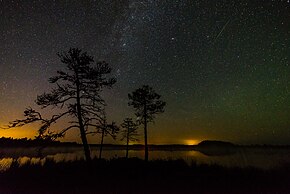
Night or nighttime is the period of ambient darkness when the Sun is below the horizon.
The word can be used in a social sense as the time between bedtime and morning. In common communication, it is a farewell (sometimes lengthened to "good night"), mainly when someone is going to sleep or leaving.
Astronomical night is the period between astronomical dusk and astronomical dawn when the Sun is between 18 and 90 degrees below the horizon and does not illuminate the sky. As seen from latitudes between about 48.56° and 65.73° north or south of the equator, complete darkness does not occur around the summer solstice because, although the Sun sets, it is never more than 18° below the horizon at lower culmination, −90° Sun angles occur at the Tropic of Cancer on the December solstice and Tropic of Capricorn on the June solstice, and at the equator on equinoxes. And as seen from latitudes greater than 72° north or south of the equator, complete darkness does not occur in both equinoxes because, although the Sun sets, it is never more than 18° below the horizon.
The opposite of night is day (or "daytime", to distinguish it from "day" referring to a 24-hour period time). Twilight is the period of night after sunset or before sunrise when the Sun still illuminates the sky when it is below the horizon. At any given time, one side of Earth is bathed in sunlight (the daytime), while the other side is in darkness caused by Earth blocking the sunlight. The central part of the shadow is called the umbra, where the night is darkest.
Natural illumination at night is still provided by a combination of moonlight, planetary light, starlight, zodiacal light, gegenschein, and airglow. In some circumstances, aurorae, lightning, and bioluminescence can provide some illumination. The glow provided by artificial lighting is sometimes referred to as light pollution because it can interfere with observational astronomy and ecosystems.
Silent night! Holy night! All is calm, all is bright Round yon virgin mother and child! Holy infant, so tender and mild, Sleep in heavenly peace! Sleep in heavenly peace!
Silent night! Holy night! Shepherds quake at the sight! Glories stream from heaven afar, Heavenly hosts sing Alleluia! Christ the Saviour is born! Christ the Saviour is born!
Silent night! Holy night! Son of God, love's pure light Radiant beams from thy holy face With the dawn of redeeming grace, Jesus, Lord, at thy birth! Jesus, Lord, at thy birth!
Astronomy
Earth

The length of night on Earth varies depending on the time of year. Longer nights occur in winter, with the winter solstice being the longest. Nights are shorter in the summer, with the summer solstice being the shortest. Earth orbits the Sun on an axis tilted 23.44 degrees. Nights are longer when a hemisphere is tilted away from the Sun and shorter when a hemisphere is tilted toward the sun. As a result, the longest night of the year for the Northern Hemisphere will be the shortest night of the year for the Southern Hemisphere.
Night's duration varies least near the equator. The difference between the shortest and longest night increases approaching the poles. At the equator, night lasts roughly 12 hours throughout the year. The tropics have little difference in the length of day and night. At the 45th parallel, the longest winter night is roughly twice as long as the shortest summer night. Within the polar circles, night will last the full 24 hours of the winter solstice. The length of this polar night increases closer to the poles. Utqiagvik, Alaska, the northernmost point in the United States, experiences 65 days of polar night. At the pole itself, polar night lasts 179 days from September to March.

Over a year, there is more daytime than nighttime because of the sun's size and atmospheric refraction. The Sun is not a single point. Viewed from Earth, the Sun ranges in angular diameter from 31 to 33 arcminutes. When the center of the Sun falls level with the western horizon, half of the Sun will still be visible during sunset. Likewise, by the time the center of the Sun rises to the eastern horizon, half of the Sun will already be visible during sunrise. This shortens night by about 3 minutes in temperate zones. Atmospheric refraction bends sunlight over the horizon. On Earth, the Sun remains briefly visible after it has geometrically fallen below the horizon. This shortens night by about 6 minutes. Scattered, diffuse sunlight remains in the sky after sunset and into twilight.
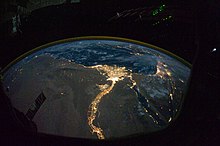
There are multiple ways to define twilight, the gradual transition to and from darkness when the Sun is below the horizon. "Civil" twilight occurs when the Sun is between 0 to 6 degrees below the horizon. Nearby planets like Venus and bright stars like Sirius are visible at this point. "Nautical" twilight continues until the sun is 12 degrees below the horizon. During nautical twilight, the horizon is visible enough for navigation. "Astronomical" twilight continues until the sun has sunk 18 degrees below the horizon. That is the point where refracted sunlight is no longer visible.
Similar to the duration of night itself, the duration of twilight varies according to latitude. At the equator, day quickly transitions to night, while the transition can take weeks near the poles. Moonlight, starlight, airglow, and light pollution create the skyglow that dimly illuminates nighttime. The amount of skyglow increases each year due to artificial lighting.
Other celestial bodies
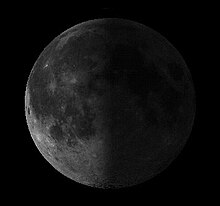
The phenomenon of day and night is due to the rotation of a celestial body about its axis, creating an illusion of the sun rising and setting. Different bodies spin at very different rates, some much faster than Earth and others extremely slowly, leading to very long days and nights. The planet Venus rotates once every 224.7 days – by far the slowest rotation period of any of the major planets. In contrast, the gas giant Jupiter's sidereal day is only 9 hours and 56 minutes. The length of a planet's orbital period determines the length of its day-night cycle as well - Venus has a rotation period of 224.7 days, but a day-night cycle just 116.75 days long due to its retrograde rotation and orbital motion around the Sun. Mercury has the longest day-night cycle as a result of its 3:2 resonance between its orbital period and rotation period - this resonance gives it a day-night cycle that is 176 days long. A planet may experience large temperature variations between day and night, such as Mercury, the planet closest to the sun.
The day-night cycle is one consideration for planetary habitability or the possibility of extraterrestrial life on distant exoplanets. Some exoplanets, like those of TRAPPIST-1, are tidally locked. Tidally locked planets have equal rotation and orbital periods, so one side experiences constant day, and the other side constant night. In these situations, astrophysicists believe that life would most likely develop in the twilight zone between the day and night hemispheres.
Biology
Living organisms react directly to the darkness of night. Light and darkness also affect circadian rhythms, the physical and mental changes that occur in a 24-hour cycle. This daily cycle is regulated by an internal "biological clock" that is adjusted by exposure to light. The length and timing of nighttime depend on location and time of year. Organisms that are more active at night possess adaptations to the night's dimmer light, increased humidity, and lower temperatures.
Animals
Animals that are active primarily at night are called nocturnal and usually possess adaptations for night vision. In vertebrates' eyes, two types of photoreceptor cells sense light. Cone cells sense color but are ineffective in low light; rod cells sense only brightness but remain effective in very dim light. The eyes of nocturnal animals have a greater percentage of rod cells. In most mammals, rod cells contain densely packed DNA near the edge of the nucleus. For nocturnal mammals, this is reversed with the densely packed DNA in the center of the nucleus, which reduces the scattering of light.

The compound eyes of insects can see at even lower levels of light. For example, the elephant hawk moth can see in color, including ultraviolet, with only starlight. Nocturnal insects navigate using moonlight, lunar phases, infrared vision, the position of the stars, and the Earth's magnetic field. Artificial lighting disrupts the biorhythms of many animals. Night-flying insects that use the moon for navigation are especially vulnerable to disorientation from increasing levels of artificial lighting. Artificial lights attract many night-flying insects that die from exhaustion and nocturnal predators. Decreases in insect populations disrupt the overall ecosystem because their larvae are a key food source for smaller fish. Dark-sky advocate Paul Bogard described the unnatural migration of night-flying insects from the unlit Nevada desert into Las Vegas as "like sparkling confetti floating in the beam's white column".
Some nocturnal animals have developed other senses to compensate for limited light. Many snakes have a pit organ that senses infrared light and enables them to detect heat. Nocturnal mice possess a vomeronasal organ that enhances their sense of smell. Bats heavily depend on echolocation. Echolocation allows an animal to navigate with their sense of hearing by emitting sounds and listening for the time it takes them to bounce back. Bats emit a steady stream of clicks while hunting insects and home in on prey as thin as human hair.
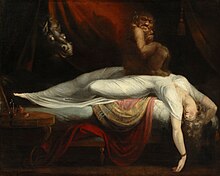
People and other diurnal animals sleep primarily at night. Humans, other mammals, and birds experience multiple stages of sleep visible via electroencephalography. The stages of sleep are wakefulness, three stages of non-rapid eye movement sleep (NREM) including deep sleep, and rapid eye movement (REM) sleep. During REM sleep, dreams are more frequent and complex. Studies show that some reptiles may also experience REM sleep. During deep sleep, memories are consolidated into long-term memory. Invertebrates most likely experience a form of sleep as well. Studies on bees, which have complex but unrelated brain structures, have shown improvements in memory after sleep, similar to mammals.
Compared to waking life, dreams are sparse with limited sensory detail. Dreams are hallucinatory or bizarre, and they often have a narrative structure. Many hypotheses exist to explain the function of dreams without a definitive answer. Nightmares are dreams that cause distress. The word "night-mare" originally referred to nocturnal demons that were believed to assail sleeping dreamers, like the incubus (male) or succubus (female). It was believed that the demons could sit upon a dreamer's chest to suffocate a victim, as depicted in John Henry Fuseli's The Nightmare.
Fungi
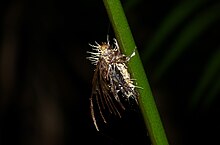
Fungi can sense the presence and absence of light, and the nightly changes of most fungi growth and biological processes are direct responses to either darkness or falling temperatures. By night, fungi are more engaged in synthesizing cellular components and increasing their biomass. For example, fungi that preys on insects will infect the central nervous system of their prey, allowing the fungi to control the actions of the dying insect. During the late afternoon, the fungi will pilot their prey to higher elevation where wind currents can carry its spores further. The fungi will kill and digest the insect as night falls, extending fruiting bodies from the host's exoskeleton. Few species of fungi have true circadian rhythms. A notable exception is Neurospora crassa, a bread mold, widely used to study biorhythms.
Plants
During the day, plants engage in photosynthesis and release oxygen. By night, plants engage in respiration, consuming oxygen and releasing carbon dioxide. Plants can draw up more water after sunset, which facilitates new leaf growth. As plants cannot create energy through photosynthesis after sunset, they use energy stored in the plant, typically as starch granules. Plants use this stored energy at a steady rate, depleting their reserves almost right at dawn. Plants will adjust their rate of consumption to match the expected time until sunrise. This avoids prematurely running out of starch reserves, and it allows the plant to adjust for longer nights in the winter. If a plant is subjected to artificially early darkness, it will ration its energy consumption to last until dawn.
Succulent plants, including cacti, have adapted to the limited water availability in arid environments like deserts. The stomata of cacti do not open until night. When the temperature drops, the pores open to allow the cacti to store carbon dioxide for photosynthesis the next day, a process known as crassulacean acid metabolism (CAM). Cacti and most night-blooming plants use CAM to store up to 99% of the carbon dioxide they use in daily photosynthesis. Ceroid cacti often have flowers that bloom at night and fade before sunrise. As few bees are nocturnal, night-flowering plants rely on other pollinators including moths, beetles, and bats. These flowers rely more on the pollinators' sense of smell with strong perfumes to attract moths and foul-smelling odors to attract bats.
Eukaryotic and prokaryotic organisms that engage in photosynthesis are also affected by nightfall. Like plants, algae will switch to taking in oxygen and processing energy stored as starch. Cyanobacteria, also known as blue algae, switch from photosynthesis to nitrogen fixation after sunset, and they absorb DNA at a much higher rate.
Effects on life
Social
Further information: Nightlife and Timeline of lighting technology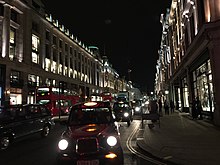
The first constant electric light was demonstrated in 1835. As artificial lighting has improved, especially after the Industrial Revolution, nighttime activity has increased and become a significant part of the economy in most places. Many establishments, such as nightclubs, bars, convenience stores, fast-food restaurants, gas stations, distribution facilities, and police stations now operate 24 hours a day or stay open as late as 1 or 2 a.m. Even without artificial light, moonlight sometimes makes it possible to travel or work outdoors at night.
Nightlife is a collective term for entertainment that is available and generally more popular from the late evening into the early hours of the morning. It includes pubs, bars, nightclubs, parties, live music, concerts, cabarets, theatre, cinemas, and shows. These venues often require a cover charge for admission. Nightlife entertainment is often more adult-oriented than daytime entertainment.
Cultural and psychological

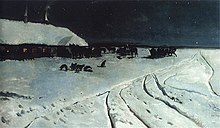

Night is often associated with danger and evil, because of the psychological connection of night's all-encompassing darkness to the fear of the unknown and darkness's hindrance of a major sensory system (the sense of sight). Nighttime is naturally associated with vulnerability and danger for human physical survival. Criminals, animals, and other potential dangers can be concealed by darkness. Midnight has a particular importance in human imagination and culture.
Upper Paleolithic art was found to show (by André Leroi-Gourhan) a pattern of choices where the portrayal of animals that were experienced as dangerous were located at a distance from the entrance of a cave dwelling at a number of different cave locations.
The belief in magic often includes the idea that magic and magicians are more powerful at night. Séances of spiritualism are usually conducted closer to midnight. Similarly, mythical and folkloric creatures such as vampires, ghosts and werewolves are described as more active at night. In almost all cultures, legendary stories warn of the night's dangers.
The cultural significance of the night in Islam differs from that in Western culture. The Quran was revealed during the Night of Power, the most significant night according to Islam. Muhammad made his famous journey from Mecca to Jerusalem and then to heaven in the night. Another prophet, Abraham, came to realize the supreme being in charge of the universe at night.
People who prefer nocturnal activity are called night owls.
See also
Notes
- "Definition of good night". merriam-webster.com. Retrieved 31 December 2019.
- ^ Dobrijevic 2022.
- Dobrijevic 2022, "What Causes the Summer Solstice".
- ^ UCSB 2015.
- Steiger & Bunton 1995, "Night and Day".
- Steiger & Bunton 1995, "Twilight".
- ^ Mulvaney 2024.
- ^ Katz 2021.
- Gaherty 2013.
- ^ McClure 2024.
- Shubinski 2023.
- ^ Mason 1933, p. 690.
- Ottewell 2019.
- Kher & Bikos n.d.
- ^ Shubinski 2023, "In twilight".
- ^ Sokol 2023.
- Flanders 2008, "Natural".
- Seidelmann et. al 2001.
- Williams 2017.
- Planetary Society n.d.
- NASA 2024.
- Clery 2017.
- Walla 2019.
- Lewis 2023.
- Iglesias et al. 2018, p. 17.
- Dunlap & Loroso 2018, p. 515.
- ^ BRAIN 2004, "Sleep and Circadian Rhythms".
- ^ Dunlap & Loroso 2018, p. 517.
- Borges 2018, "Abstract".
- ^ Gaston et al. 2012, p. 1261.
- ^ Jacobs 2009, p. 2961.
- Shen 2012.
- Cell 2009.
- Danthanarayana 1986, p. 3.
- Edwards 2018, p. 241.
- Pennisi, Benthe & Haberland 2021, p. 556.
- Pennisi, Benthe & Haberland 2021, p. 557.
- Pennisi, Benthe & Haberland 2021, pp. 556–557.
- Edwards 2018, p. 239.
- ^ Edwards 2018, p. 238.
- Langley 2021, "Bat signals".
- Moorcroft 2005, p. 33.
- Vorster & Born 2015, p. 108.
- Patel et al. 2024, "Mechanism".
- Hoel 2021, "Introduction".
- Dunham 2016.
- Vorster & Born 2015, p. 115.
- Vorster & Born 2015, p. 113.
- ^ Hoel 2021, "Contemporary Theories of Dreams".
- ^ Harris 2004, pp. 439–440.
- Dunlap & Loroso 2018, p. 528.
- Lovett & Leger 2018, pp. 935–936.
- Dunlap & Loroso 2018, pp. 515–517.
- Fricke 2020, p. 1152.
- Fricke 2020, p. 1154.
- ^ Scialdone & Howard 2015, p. 1.
- ^ Scialdone & Howard 2015, p. 2.
- Hewitt 1997, p. 10.
- ^ Hewitt 1997, p. 12.
- Herrera 2009, p. 645.
- Borges, Somanathan & Kelber 2016, p. 399.
- Herrera 2009, p. 646.
- Hewitt 1997, pp. 60–61.
- Borges, Somanathan & Kelber 2016, p. 404.
- Hewitt 1997, p. 13.
- Carnegie Institution 2014.
- Lutz n.d.
- Coombs 2006.
- Leitch 2020.
- Matulka, Rebecca; Wood, Daniel (22 November 2013). "The History of the Light Bulb". Department of Energy. Archived from the original on 25 May 2021. Retrieved 25 May 2021.
- "Nightlife – Definition of nightlife by Merriam-Webster". merriam-webster.com.
- moma learning. MoMA. Retrieved May 23, 2021.
- Leroi-Gourhan; Lewis-Williams, JD (24 April 2014). Zvelebil, Marek; Jordan, Peter; Cummings, Vicki (eds.). Art for the Living, in, The Oxford Handbook of the Archaeology and Anthropology of Hunter-Gatherers (Ebook). OUP Oxford. ISBN 9780191025266. Retrieved 26 May 2021. The source doesn't state whether the location "painted in the depths" had natural light or no natural light.
- Klein, Stefan (2008). Time. p. 20.
References
- Beaumont, Matthew (2014), "The Mystery of Master Humphrey: Dickens, Nightwalking and "the Old Curiosity Shop"", The Review of English Studies, vol. 65, no. 268, pp. 118–136, ISSN 0034-6551, retrieved 8 April 2024
- Borges, Renee M.; Somanathan, Hema; Kelber, Almut (2016). "Patterns and Processes in Nocturnal and Crepuscular Pollination Services". The Quarterly Review of Biology. 91 (4): 389–418. doi:10.1086/689481.
- Borges, Renee M. (March 2018). "Dark Matters: Challenges of Nocturnal Communication Between Plants and Animals in Delivery of Pollination Services". The Yale journal of biology and medicine. 91 (1): 33–42. PMID 29599655.
- Boyer, Anne (2019). "The Fall of Night". Lapham’s Quarterly. Vol. 12, no. 1. ISSN 1935-7494.
- BRAIN (2004). Brain Resources and Information Network (BRAIN). "Brain Basics: Understanding Sleep". National Institute of Neurological Disorders and Stroke. Archived from the original on 23 January 2005. 2023 update.
- Bronfen, Elisabeth (2013). Night passages: philosophy, literature, and film. New York: Columbia University Press. ISBN 978-0-231-14798-9.
- Carnegie Institution (10 November 2014). "Biochemistry detective work: Algae at night". ScienceDaily.
- Cell (22 April 2009). "Night vision". Nature. 458 (948). doi:10.1038/458948a.
- Clery, Daniel (1 November 2017). "Earth-sized alien worlds are out there. Now, astronomers are figuring out how to detect life on them". Science. American Association for the Advancement of Science. Retrieved 29 February 2024.
- Coombs, Amy (30 January 2006). "Cyanobacteria Work the Night Shift". Science. Retrieved 19 April 2024.
- Danthanarayana, W., ed. (1986). Insect Flight. Springer. ISBN 978-3-642-71157-2.
- Dickens, Charles (2012) . "Night Walks". Broadview Anthology of British Literature: The Victorian Era. Vol. 5 (Second ed.). Broadview Press.
- Dobrijevic, Daisy (26 September 2022). "The summer solstice: What is it and when does it occur?". Space. Retrieved 20 April 2024.
- Dunham, Will (29 April 2016). "Slumber Party: Reptiles, like Us, Have REM Sleep and May Dream". Scientific American.
- Dunlap, Jay C.; Loroso, Jennifer J. (2018). "Making Time: Conservation of Biological Clocks from Fungi to Animals". The Fungal Kingdom. American Society for Microbiology. doi:10.1128/microbiolspec.FUNK-0039-2016.
- Edwards, Nina (2018). Darkness: A Cultural History. London: Reaktion Books. ISBN 978-1-78023-982-8.
- Flanders, Tony (5 December 2008). "Rate Your Skyglow". Retrieved 16 April 2024.
- Fricke, Wieland (February 2020). "Energy costs of salinity tolerance in crop plants: night‐time transpiration and growth". New Phytologist. 225 (3): 1152–1165. doi:10.1111/nph.15773.
- Gaherty, Geoff (7 May 2013). "This Week's 'Ring of Fire' Solar Eclipse: What You Need to Know". Space.com. Retrieved 20 April 2024.
- Gaston, Kevin J.; Davies, Thomas W.; Bennie, Jonathan; Hopkins, John (December 2012). "Review: Reducing the ecological consequences of night‐time light pollution: options and developments". Journal of Applied Ecology. 49 (6): 1256–1266. doi:10.1111/j.1365-2664.2012.02212.x.
- Harris, James C. (1 May 2004). "The Nightmare". Archives of General Psychiatry. 61 (5): 439. doi:10.1001/archpsyc.61.5.439.
- Herrera, Ana (2009). "Crassulacean acid metabolism and fitness under water deficit stress: if not for carbon gain, what is facultative CAM good for?". Annals of Botany. 103 (4): 645–653. doi:10.1093/aob/mcn145.
- Hewitt, Terry (1997). The complete book of cacti & succulents. New York: Dorling Kindersley. ISBN 978-0-7894-1657-5.
- Hoel, Erik (May 2021). "The overfitted brain: Dreams evolved to assist generalization". Patterns. 2 (5): 100244. doi:10.1016/j.patter.2021.100244.
- Hurkman, Alexis Van (2013). Color Correction Look Book: Creative Grading Techniques for Film and Video. Peachpit Press. ISBN 978-0-13-381847-5.
- Katz, Osnat (18 March 2021). "Day and night aren't equal length on an equinox – here's why". The Conversation. Retrieved 20 April 2024.
- Iglesias, Teresa L.; Dornburg, Alex; Warren, Dan L.; Wainwright, Peter C.; Schmitz, Lars; Economo, Evan P. (2018). "Eyes Wide Shut: the impact of dim-light vision on neural investment in marine teleosts". Journal of Evolutionary Biology. 31 (8): 1082–1092. doi:10.1111/jeb.13299. ISSN 1420-9101. PMID 29808568. S2CID 44161422.
- Jacobs, Gerald H. (12 October 2009). "Evolution of colour vision in mammals". Philosophical Transactions of the Royal Society B: Biological Sciences. 364 (1531): 2957–2967. doi:10.1098/rstb.2009.0039. ISSN 0962-8436. PMID 19720656.
- Keimig, Lance (2012). Night Photography: Finding your way in the dark. Taylor & Francis. ISBN 978-1-136-09725-6.
- Kher, Aparna; Bikos, Konstantin (n.d.). "Twilight, Dawn, and Dusk". Time and Date. Retrieved 21 April 2024.
- Kramer, Fritz (24 October 2015). "Silent Movies 101: Color before sound (and why colorization is not always a bad thing)". Movies Silently. Retrieved 6 April 2024.
- Langley, Liz (3 February 2021). "Echolocation is nature's built-in sonar. Here's how it works". National Geographic.
- Leitch, Carmen (13 April 2020). "Even Bacteria Align With the Daily Cycle of Day and Night". Labroots.
- Lewis, Briley (5 April 2023). "Aliens could be hiding in 'terminator zones' on planets with eternal night". Space.
- Lovett, Brian; Leger, Raymond St. J. (2018). "The Insect Pathogens". The Fungal Kingdom. American Society for Microbiology. doi:10.1128/microbiolspec.FUNK-0001-2016.
- Lutz, C. Greg (n.d.). "Louisiana Fisheries - Fact Sheets". Sea Grant. Louisiana State University. Retrieved 19 April 2024.
- Ottewell, Guy (14 June 2019). "The undark nights of summer". EarthSky. Retrieved 21 April 2024.
- Mason, W. A. (May 1933). "Twilight". United States Naval Institute Proceedings. Vol. 59, no. 363.
- McClure, Bruce (19 March 2024). "On the equinox, are day and night equal?". EarthSky. Retrieved 20 April 2024.
- Moorcroft, William H. (2005). Understanding Sleep and Dreaming (Second ed.). New York: Springer. ISBN 978-1-4614-6466-2.
- Mulvaney, Kieran (20 April 2024). "What is polar night?". National Geographic. Retrieved 20 April 2024.
- NASA. (2024) "Mercury: Facts". NASA Science. 2024. Retrieved 14 February 2024.
- Patel, Aakash K.; Reddy, Vamsi; Shumway, Karlie R.; Araujo, John F. (2024). "Physiology, Sleep Stages". StatPearls. StatPearls Publishing. Retrieved 18 April 2024.
- Pennisi, Elizabeth; Benthe, H. F.; Haberland, G. (7 May 2021). "Fatal attraction to light at night pummels insects". Science. 372 (6542): 556–557. doi:10.1126/science.372.6542.556.
- Planetary Society (n.d.). "The Terrestrial Planets: Mercury, Venus, Earth, The Moon, and Mars". Space Topics. Archived from the original on 28 July 2011. Retrieved 12 April 2007.
- Rabiger, Michael (2014). Directing: Film Techniques and Aesthetics. CRC Press. ISBN 978-1-136-06686-3.
- Read, Paul (2009). "'Unnatural Colours': An introduction to Colouring Techniques in Silent Era Movies". Film History. 21 (1): 7–46. ISSN 0892-2160.
- Scialdone, Antonio; Howard, Martin (31 March 2015). "How plants manage food reserves at night: quantitative models and open questions". Frontiers in Plant Science. 6. doi:10.3389/fpls.2015.00204.
- Seidelmann, P. K.; Abalakin, V. K.; Bursa, M.; Davies, M. E.; et al. (2001). "Report of the IAU/IAG Working Group on Cartographic Coordinates and Rotational Elements of the Planets and Satellites: 2000". HNSKY Planetarium Program. Archived from the original on 2 December 2018. Retrieved 2 February 2007.
- Shen, Li (9 July 2012). "Night Vision: How Animals See in the Dark". The Outside Story.
- Shubinski, Raymond (9 November 2023). "Discover the three kinds of twilight". Astronomy Magazine. Retrieved 20 April 2024.
- Sokol, Joshua (19 January 2023). "Light pollution is drowning the starry night sky faster than thought". Science. doi:10.1126/science.adg7722.
- Steiger, Walter R.; Bunton, George W. (1995). Night and Day. California Institute of Technology.
- "If you wanted to enjoy longer periods of daylight in the summertime would you head closer to the equator or farther from it?". Science Line. University of California Santa Barbara. Retrieved 20 April 2024.
- Vorster, Albrecht P.; Born, Jan (March 2015). "Sleep and memory in mammals, birds and invertebrates". Neuroscience & Biobehavioral Reviews. 50: 103–119. doi:10.1016/j.neubiorev.2014.09.020.
- Walla, Emily (10 April 2019). "Powerful Particles and Tugging Tides May Affect Extraterrestrial Life". University of Arizona News.
- Williams, Matt (7 February 2017). "How Long is a Day on Venus?". Universe Today. Retrieved 14 February 2024.
External links
Listen to this article (4 minutes) Media related to Night at Wikimedia Commons
Media related to Night at Wikimedia Commons Quotations related to Night at Wikiquote
Quotations related to Night at Wikiquote The dictionary definition of night at Wiktionary
The dictionary definition of night at Wiktionary- International Night Studies Network
| Parts of a day | ||
|---|---|---|
| Daytime |  | |
| Twilight | ||
| Night | ||
| Related | ||